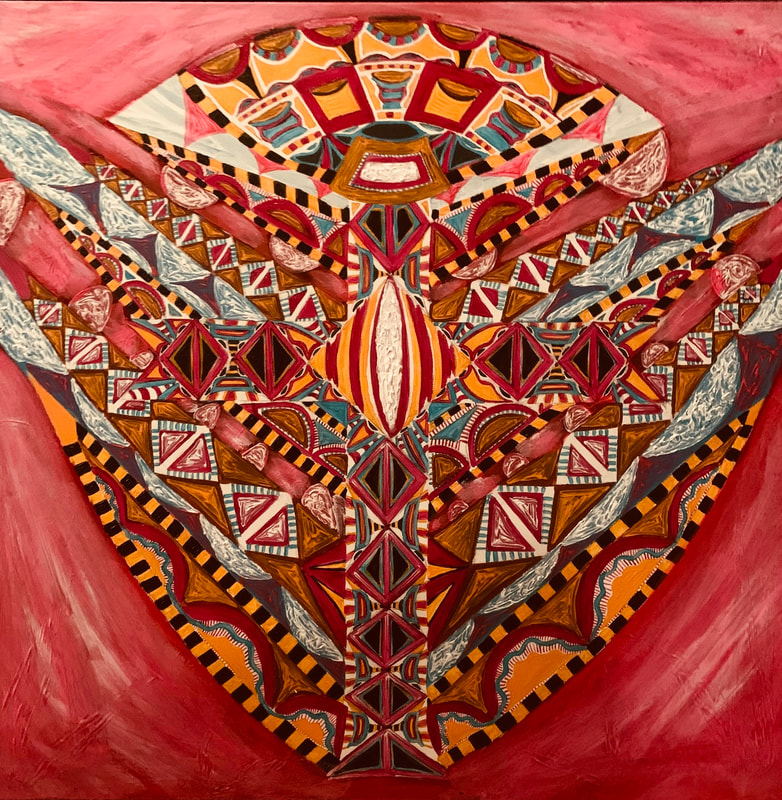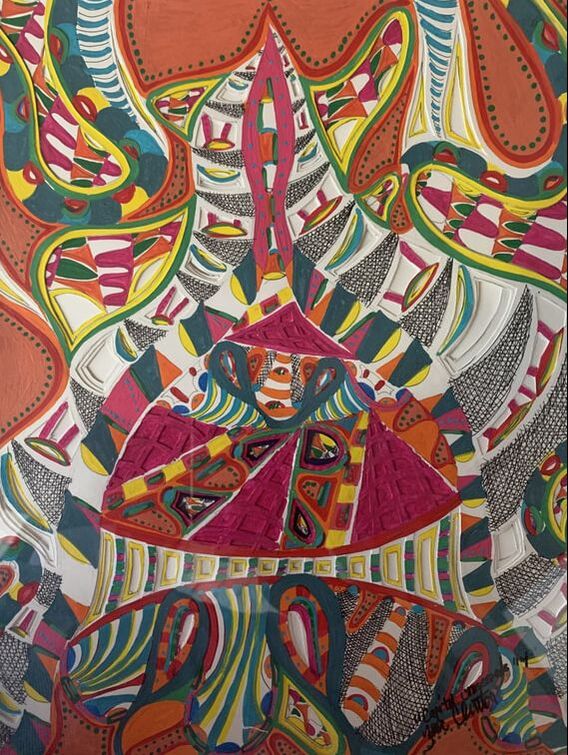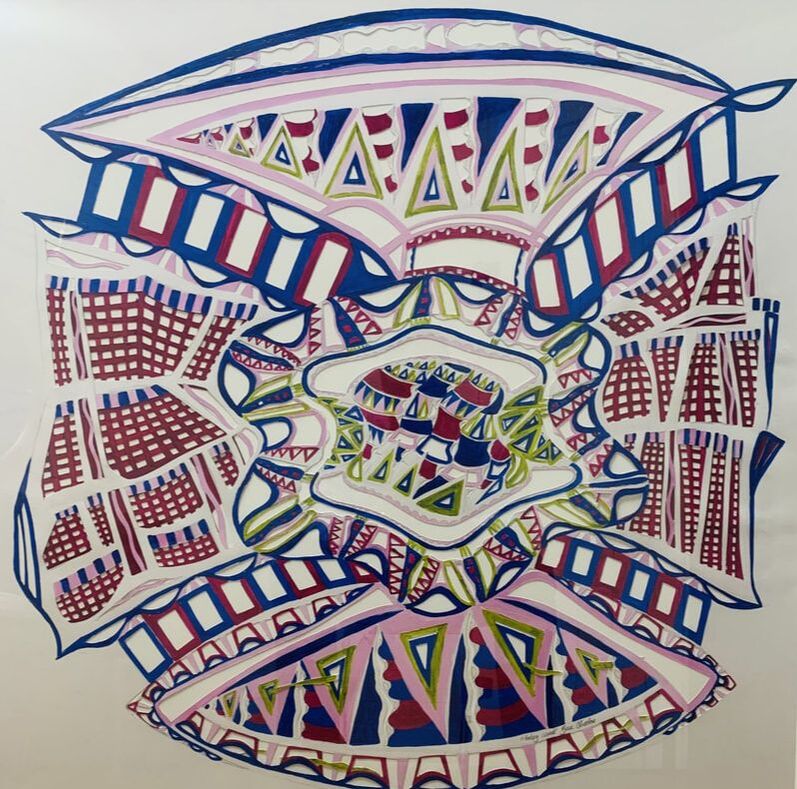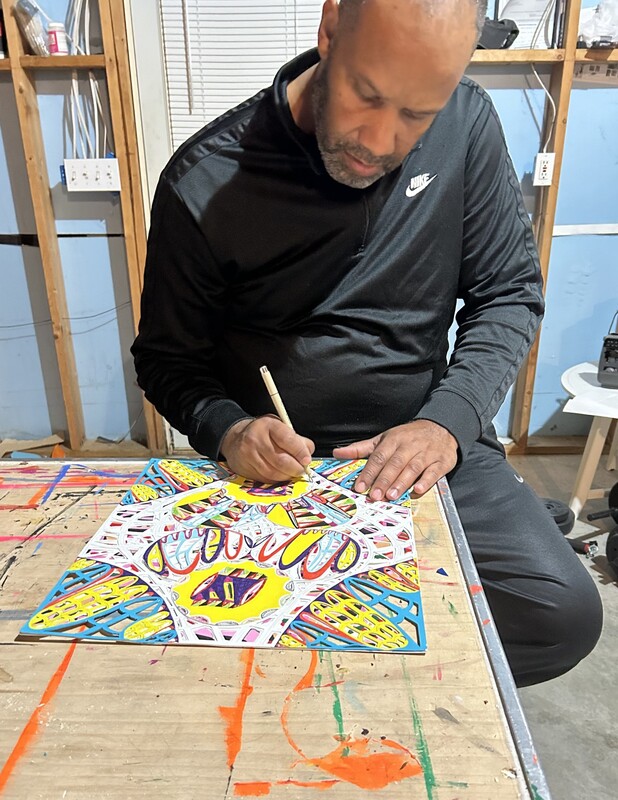Dr. Zerric Clinton is an artist educator who resides in metro Atlanta. He has taught art education at the secondary level for over 20 years. Zerric is a lifelong artist educator who teaches art and creates abstract works of art based on social issues, personal experiences and various forms of music. Recent shows include PIVOT: Restoring Balance, Emma Darnell Aviation Museum, Atlanta, GA. ICON exhibit, d’Art Center, Norfolk, VA., Healing Humanity exhibit at Steffen Thomas Museum of Art, Buckhead, GA. Dr. Zerric Clinton recently launched his new book The Power of Popular Culture in Education: History, Music and Visual Imagery, which was written to benefit young people in developing the skill of critically viewing media. Dr. Clinton’s book is available for purchase at https://www.positivepushpress.com/ and https://www.amazon.com/.
Published on March 3rd, 2024. Artist responses collected in months previous.
What are you working on these days?
These days I am preparing for several shows. I am a part of a couple of two- person shows going on right now. One is called Opposite Ends of the Spectrum and it is occurring at Gallery at Hood Street. In this exhibition my counterpart is a renderer that creates images of people and my work is conceptual in that I create abstract works of art based on a variety of topics. Additionally, I recently had an opening for my solo show Identity Politics as Arts Clayton Gallery. In this exhibition my work focuses on social issues that we are presently encountering. In each image there symbolism exists, but the viewer has to become intimate with the work to figure out the meanings that are associated with each piece. Color, line and shape are used in various ways to enhance each work of art to create intrigue.
What has been going well for you in your art career and life recently?
Earlier this year I published my book The Power of Popular Culture: History, Music and Visual Imagery. I was honored to have my book launch at the High Museum of Art in Atlanta and it went really well. Since that time I have been called on to do several presentations on this book and it has been well received. Additionally, I have been really been busy creating work for another project that deals with social issues. I was among five artists to be selected for this project. In terms of my teaching career my students are receiving accolades and that makes me feel great knowing that they are prospering. Also, I recently learned that one of my previous students has not opened a restaurant and used his artistic skills to create all the artwork for the walls in his establishment. There are two of my students that have become art teachers recently and they are doing very well in the academic setting.
What is something new that you have discovered this past year that is meaningful or helpful for you?
As an artist I am learning that the more art shows I attend the more I am able to learn about being an artist. There is no reason to work in a silo. You have to be open to learning as an artist to grow and you must be open to criticism as well. No matter how much success you have you must continue to read, listen to artist talks, visit museums and galleries, and be open to mentoring other artists. This mentoring piece is very new to me so I am incorporating some of the same things that my mentors have done for me over the years. I am excited to see so many older artists that are creating art at a high level well into their 80s.
Briefly walk us through your process of making art or thinking through a new project, focusing on what's most important to you as you create.
For me creating works on paper is the process that I use the most. I use bristol board as the starting point for my drawings and begin my initial cutouts. Then, I place other cutouts underneath those areas to create depth and use a variety of color combinations. Using such a variety of color combinations will hopefully be interesting to the viewer. Another layer that I have here is to include subtle symbolism in the works that will compel the viewer to be intimate with the works of art. That is one of the main reasons that I use this process because I want the viewer to tell me what they see and I have often learned just as much from them as they may learn from my work.
Is there anything else that you would like to share with our readers?
I always look forward to completing this every year. It always compels me to think more intently about what I am doing in the art world. Additionally, I look forward to seeing the work of other people that are a part of this project. The variety of artists that are a part of this project make it very intriguing to people that are not visual artists. There are several friends of mine and art collectors that are checking out the artists that are a part of this project.
What are you working on these days?
These days I am preparing for several shows. I am a part of a couple of two- person shows going on right now. One is called Opposite Ends of the Spectrum and it is occurring at Gallery at Hood Street. In this exhibition my counterpart is a renderer that creates images of people and my work is conceptual in that I create abstract works of art based on a variety of topics. Additionally, I recently had an opening for my solo show Identity Politics as Arts Clayton Gallery. In this exhibition my work focuses on social issues that we are presently encountering. In each image there symbolism exists, but the viewer has to become intimate with the work to figure out the meanings that are associated with each piece. Color, line and shape are used in various ways to enhance each work of art to create intrigue.
What has been going well for you in your art career and life recently?
Earlier this year I published my book The Power of Popular Culture: History, Music and Visual Imagery. I was honored to have my book launch at the High Museum of Art in Atlanta and it went really well. Since that time I have been called on to do several presentations on this book and it has been well received. Additionally, I have been really been busy creating work for another project that deals with social issues. I was among five artists to be selected for this project. In terms of my teaching career my students are receiving accolades and that makes me feel great knowing that they are prospering. Also, I recently learned that one of my previous students has not opened a restaurant and used his artistic skills to create all the artwork for the walls in his establishment. There are two of my students that have become art teachers recently and they are doing very well in the academic setting.
What is something new that you have discovered this past year that is meaningful or helpful for you?
As an artist I am learning that the more art shows I attend the more I am able to learn about being an artist. There is no reason to work in a silo. You have to be open to learning as an artist to grow and you must be open to criticism as well. No matter how much success you have you must continue to read, listen to artist talks, visit museums and galleries, and be open to mentoring other artists. This mentoring piece is very new to me so I am incorporating some of the same things that my mentors have done for me over the years. I am excited to see so many older artists that are creating art at a high level well into their 80s.
Briefly walk us through your process of making art or thinking through a new project, focusing on what's most important to you as you create.
For me creating works on paper is the process that I use the most. I use bristol board as the starting point for my drawings and begin my initial cutouts. Then, I place other cutouts underneath those areas to create depth and use a variety of color combinations. Using such a variety of color combinations will hopefully be interesting to the viewer. Another layer that I have here is to include subtle symbolism in the works that will compel the viewer to be intimate with the works of art. That is one of the main reasons that I use this process because I want the viewer to tell me what they see and I have often learned just as much from them as they may learn from my work.
Is there anything else that you would like to share with our readers?
I always look forward to completing this every year. It always compels me to think more intently about what I am doing in the art world. Additionally, I look forward to seeing the work of other people that are a part of this project. The variety of artists that are a part of this project make it very intriguing to people that are not visual artists. There are several friends of mine and art collectors that are checking out the artists that are a part of this project.
Find Zerric Clinton on Instagram








